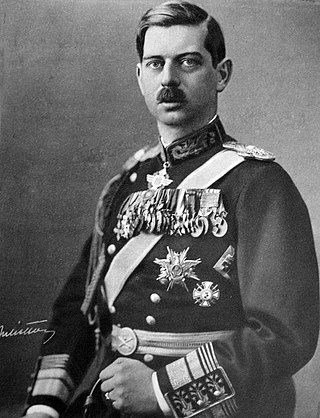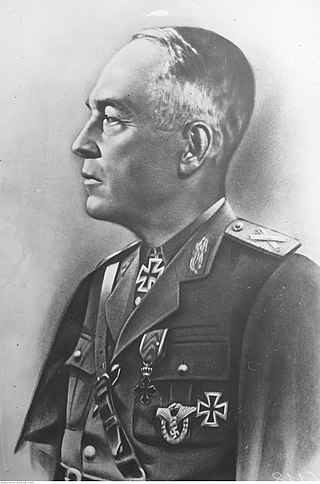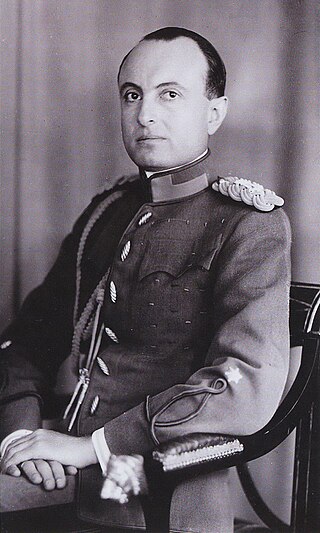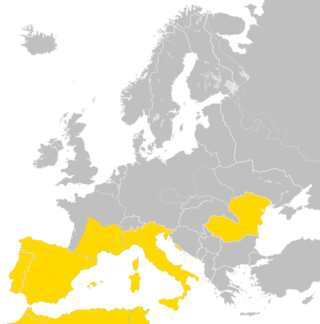
Carol II was the King of Romania from 8 June 1930 until his forced abdication on 6 September 1940. As the eldest son of Ferdinand I, he became crown prince upon the death of his grand-uncle, King Carol I, in 1914. He was the first of the Hohenzollern kings of Romania to be born in the country; as both of his predecessors had been born in Germany and came to Romania only as adults. As such, he was the first member of the Romanian branch of the Hohenzollerns who spoke Romanian as his first language and was also the first member of the royal family to be raised in the Orthodox faith.

Ion Antonescu was a Romanian military officer and marshal who presided over two successive wartime dictatorships as Prime Minister and Conducător during most of World War II. Having been responsible for facilitating the Holocaust in Romania, he was tried for war crimes and executed in 1946.

The Axis powers, originally called the Rome–Berlin Axis and also known as the Rome-Berlin-Tokyo Axis, was a military coalition that initiated World War II and fought against the Allies. Its principal members were Nazi Germany, the Kingdom of Italy, and the Empire of Japan. The Axis were united in their far-right positions and general opposition to the Allies, but otherwise lacked comparable coordination and ideological cohesion.

The Tripartite Pact, also known as the Berlin Pact, was an agreement between Germany, Italy, and Japan signed in Berlin on 27 September 1940 by, respectively, Joachim von Ribbentrop, Galeazzo Ciano and Saburō Kurusu and in the presence of Adolf Hitler. It was a defensive military alliance that was eventually joined by Hungary, Romania, Bulgaria and Yugoslavia as well as by the German client state of Slovakia. Yugoslavia's accession provoked a coup d'état in Belgrade two days later. Germany, Italy and Hungary responded by invading Yugoslavia. The resulting Italo-German client state, known as the Independent State of Croatia, joined the pact on 15 June 1941.

The Pact of Steel, formally known as the Pact of Friendship and Alliance between Germany and Italy, was a military and political alliance between Italy and Germany.
The Kingdom of Romania, under the rule of King Carol II, was initially a neutral country in World War II. However, Fascist political forces, especially the Iron Guard, rose in popularity and power, urging an alliance with Nazi Germany and its allies. As the military fortunes of Romania's two main guarantors of territorial integrity—France and Britain—crumbled in the Fall of France, the government of Romania turned to Germany in hopes of a similar guarantee, unaware that Germany, in the supplementary protocol to the 1939 Molotov–Ribbentrop Pact, had already granted its blessing to Soviet claims on Romanian territory.

The Little Entente was an alliance formed in 1920 and 1921 by Czechoslovakia, Romania and the Kingdom of Serbs, Croats and Slovenes with the purpose of common defense against Hungarian revisionism and the prospect of a Habsburg restoration in Austria or Hungary. France supported the alliance by signing treaties with each member country. The rapid growth of German power caused its collapse in 1938, and it never went into wartime operation.

Prince Paul of Yugoslavia, also known as Paul Karađorđević, was prince regent of the Kingdom of Yugoslavia during the minority of King Peter II. Paul was a first cousin of Peter's father, Alexander I.

Milan Stojadinović was a Serbian and Yugoslav politician and economist who served as the Prime Minister of Yugoslavia from 1935 to 1939. He also served as Foreign Minister from 1935 to 1939 and as Minister of Finance three times.

Mihai Antonescu was a Romanian politician who served as Deputy Prime Minister and Foreign Minister during World War II, executed in 1946 as a war criminal.

The Balkan Pact, or Balkan Entente, was a treaty signed by Greece, Romania, Turkey and Yugoslavia on 9 February 1934 in Athens, aimed at maintaining the geopolitical status quo in the region after the end of World War I. To present a united front against Bulgarian designs on their territories, the signatories agreed to suspend all disputed territorial claims against one another and their immediate neighbours following the aftermath of the war and a rise in various regional irredentist tensions.
The Polish–Romanian alliance was a series of treaties signed in the interwar period by the Second Polish Republic and the Kingdom of Romania. The first of them was signed in 1921 and, together, the treaties formed a basis for good foreign relations between the two countries that lasted until World War II began in 1939.

The National Legionary State was a totalitarian fascist regime which governed Romania for five months, from 14 September 1940 until its official dissolution on 14 February 1941. The regime was led by General Ion Antonescu in partnership with the Iron Guard, the Romanian ultra-nationalist, anti-Semitic, and anti-communist organization. Though the Iron Guard had been in the Romanian Government since 28 June 1940, on 14 September it achieved dominance, leading to the proclamation of the National Legionary State.

The 1944 Romanian coup d'état, better known in Romanian historiography as the Act of 23 August, was a coup d'état led by King Michael I of Romania during World War II on 23 August 1944. With the support of several political parties, the king removed the government of Ion Antonescu, which had aligned Romania with Nazi Germany, after the Axis front in northeastern Romania collapsed in the face of a successful Soviet offensive. The Romanian Army declared a unilateral ceasefire with the Soviet Red Army on the Moldavian front, an event viewed as decisive in the Allied advances against the Axis powers in the European theatre of World War II. The coup was supported by the Romanian Communist Party, the Social Democratic Party, the National Liberal Party, and the National Peasants' Party who had coalesced into the National Democratic Bloc in June 1944.
The Treaty of Nettuno was an agreement made between the governments of the Kingdom of Italy and the Kingdom of Serbs, Croats and Slovenes on July 20, 1925, which permitted Italians to freely immigrate into Yugoslavia's coastal region of Dalmatia. Its ratification in the Yugoslav parliament took three years, as opposition Croatian Peasant Party representatives were infuriated with the treaty, calling it colonization by Benito Mussolini.

Romania–Slovakia relations are the foreign relations between Romania and Slovakia. The history of relations between the two countries dates back to 30 January 1920, when Czechoslovakia and Romania officially established their diplomatic relations. During the interwar period, Romania, Czechoslovakia and Yugoslavia created an alliance, the Little Entente. Furthermore, during the Second World War, Romania and Slovakia, as well as Croatia, created a pact against Hungarian expansion. During the war, Slovak troops and Croatian air and naval forces operated amicably from Romanian soil. At the end of this war, Romanian troops fought against German soldiers to liberate Slovakia. Those Romanians who died were buried in the Military Cemetery of Zvolen. During the Warsaw Pact invasion of Czechoslovakia of 1968, Romania declared its opposition to the operation. In celebration of the 25th anniversary of the establishment of relations between Romania and Slovakia, stamps of the Military Cemetery of Zvolen with a nominal value of 8 lei (1.65€) were minted.

The Latin Axis was a proposed alliance between European Latin countries during the Second World War. This project was proposed to Italy by Romanian politician Mihai Antonescu, who served as Deputy Prime Minister and Foreign Minister during World War II, under Ion Antonescu. The alliance would have included Romania, Italy, Vichy France, Spain, and Portugal. As a consolidated bloc in a region of German weakness, he hoped that it might become a significant counterweight to the Reich. Germany supported the proposal for the Latin Bloc during World War II and German propaganda assisted Italian propaganda in promoting the bloc. However, the alliance failed to materialize. Germany's Führer Adolf Hitler promoted the Latin Bloc and in October 1940 travelled to Hendaye, France, on the border with Spain to meet Franco with whom he promoted Spain forming a Latin bloc with Italy and Vichy France to join Italy's fight against the United Kingdom in the Mediterranean region.

The territorial evolution of Romania includes all the changes in the country's borders from its formation to the present day. The precedents of Romania as an independent state can be traced back to the 14th century, when the principalities of Moldavia and Wallachia were founded. Wallachia during its history lost several portions of its territory, either to the Ottomans or the Habsburgs. However, this land would be later essentially recovered in its entirety. Moldavia, on the other hand, suffered great territorial losses. In 1774, the Habsburgs invaded Bukovina and annexed it one year later, and in 1812, the Russian Empire took control of Bessarabia. Both territories were later exposed to powerful colonization policies. The principalities declared unification in 1859 as the Principality of Romania. This new state sought independence from the Ottoman Empire's vassalage, and in 1878, it fought a war against it alongside Russia. However, the latter would annex Southern Bessarabia, which was recovered decades before. Romania received Northern Dobruja as compensation, and would wage a war for the southern part against Bulgaria in 1913.

Romania–Yugoslavia relations were historical foreign relations between Romania and now broken up Yugoslavia. Relations between Romania and independent South Slavic states developed before creation of Yugoslavia and union of Transylvania with Romania and those relations played prominent role during the Second Balkan War. Relations between the two states were generally friendly and were only occasionally affected by wider alliance policies.
The Romanian resistance movement during World War II was manifested in several ways.




















